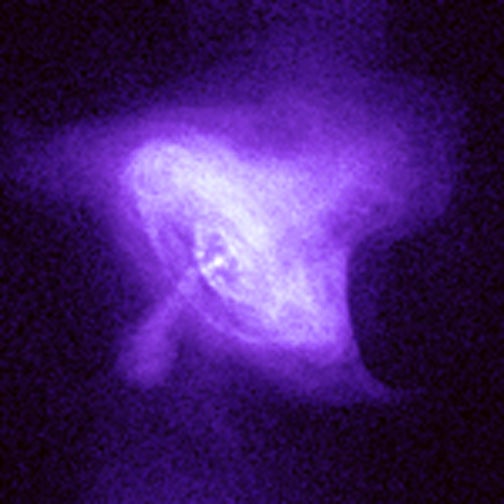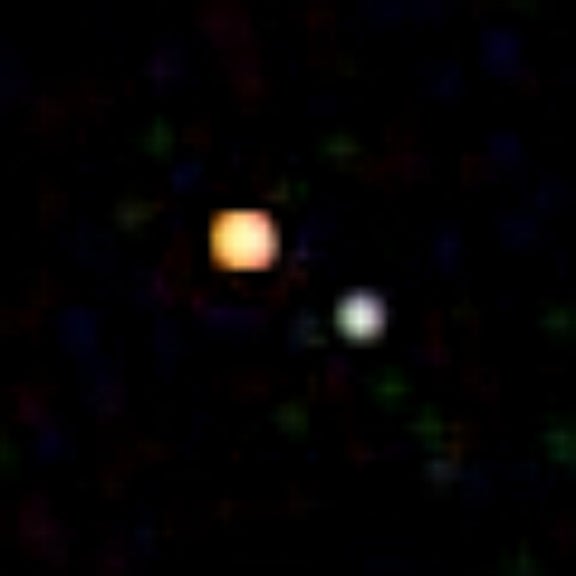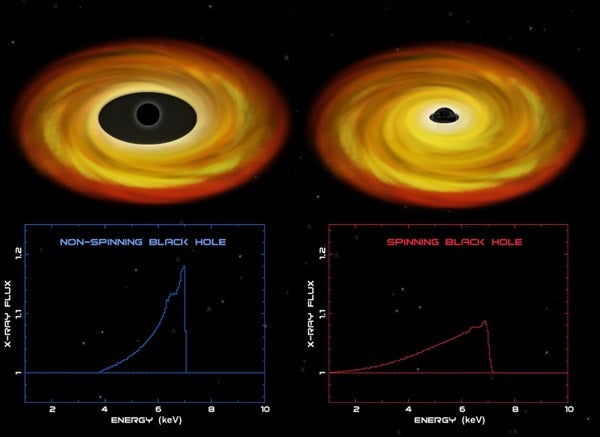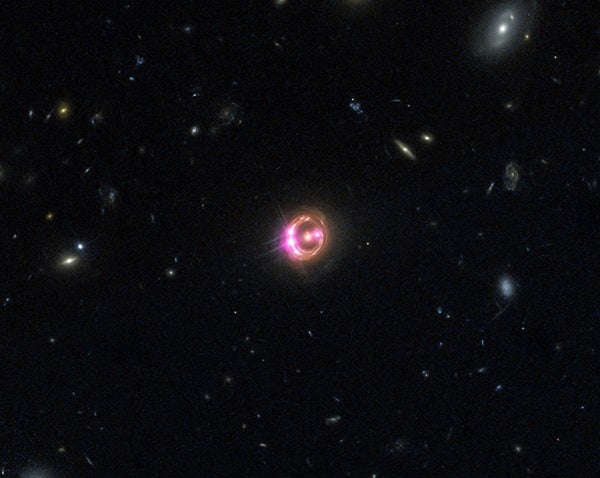CHANDRA DISCOVERS X-RAY RING AROUND COSMIC POWERHOUSE IN CRAB NEBULA
September 28, 1999
After barely two months in space, NASA’s Chandra X-ray Observatory has taken a stunning image of the Crab Nebula (M1), the spectacular remains of a stellar explosion, and has revealed something never seen before: a brilliant ring around the nebula’s heart.
Combined with observations from the Hubble Space Telescope, the image provides important clues to the puzzle of how the cosmic “generator,” a pulsing neutron star, energizes the nebula, which still glows brightly almost 1,000 years after the explosion.
“The inner ring is unique,” said Jeff Hester of Arizona State University in Tempe. “It has never been seen before, and it should tell us a lot about how the energy from the pulsar gets into the nebula. It’s like finding the transmission lines between the power plant and the light bulb.”
Mal Ruderman of Columbia University in New York agreed. “The X-rays Chandra sees are the best tracer of where the energy is. With images such as these, we can directly diagnose what is going on.”
What is going on, according to Martin Weisskopf, Chandra project scientist from NASA’s Marshall Space Flight Center in Huntsville, Alabama, is awesome. “The Crab pulsar is accelerating particles up to the speed of light and flinging them out into interstellar space at an incredible rate.”
The image shows tilted rings or waves of high-energy particles that appear to have been flung outward over the distance of a light year from the central star. High-energy jets of particles blasting away from the neutron star in a direction perpendicular to the rings are also visible.
Hubble Space Telescope images have shown moving knots and wisps around the neutron star, and previous X-ray images have shown the outer parts of the jet and hinted at the ring structure. With Chandra’s exceptional resolution, the jet can be traced all the way in to the neutron star, and the ring pattern clearly appears. The image was made with Chandra’s Advanced CCD Imaging Spectrometer and High Energy Transmission Grating.
The Crab Nebula, easily the most intensively studied object beyond our solar system, is the remnant of a star that was observed to explode in 1054 A.D. Chinese astronomers in that year reported a “guest star” that appeared suddenly and remained visible for weeks, even during daytime. The Crab has been observed using virtually every astronomical instrument that could see that part of the sky, from gamma-ray telescopes to radio telescopes.
Unraveling the mysteries of the Crab has proven to be the door to insight after insight into the workings of the universe. The Crab convincingly tied the origin of enigmatic “pulsars” to the stellar cataclysms known as supernovas. Observations of the expanding cloud of filaments in the Crab were instrumental in confirming the cosmic origin of the chemical elements from which planets (and people) are made.
The nebula is located 6,000 light-years from Earth in the constellation Taurus. The Crab pulsar, which was discovered by radio astronomers in 1968, is a neutron star rotating 30 times per second. Neutron stars are formed in the seconds before a supernova explosion when gravity crushes the central core of the star to densities 50 trillion times that of lead and a diameter of only 12 miles (19 kilometers).
Another consequence of the dramatic collapse is that neutron stars are rapidly rotating and highly magnetized. Like a gigantic cosmic generator, the rotating magnet generates 10 quadrillion volts of electricity, 30 million times that of a typical lightning bolt.
“It is an incredibly efficient generator,” Ruderman explained. “More than 95 percent efficient. There’s nothing like it on Earth.”
September 19, 2002
Just when it seemed like the summer movie season had ended, two of NASA’s Great Observatories have produced their own action movie. Multiple observations made over several months with Chandra X-ray Observatory and the Hubble Space Telescope captured the spectacle of matter and antimatter propelled to near the speed of light by the Crab pulsar, a rapidly rotating neutron star the size of Manhattan.
“Through this movie, the Crab Nebula has come to life,” said Jeff Hester of Arizona State University in Tempe, lead author of a paper in the September 20 issue of The Astrophysical Journal Letters. “We can see how this awesome cosmic generator actually works.”
The Crab was first observed by Chinese astronomers in 1054 A.D. and has since become one of the most studied objects in the sky. By combining the power of both Chandra and Hubble, the movie reveals features never seen in still images. By understanding the Crab, astronomers hope to unlock the secrets of how similar objects across the universe are powered.
Bright wisps can be seen moving outward at half the speed of light to form an expanding ring that is visible in both X-ray and optical images. These wisps appear to originate from a shock wave that shows up as an inner X-ray ring. This ring consists of about two dozen knots that form, brighten and fade, jitter around, and occasionally undergo outbursts that give rise to expanding clouds of particles, but remain in roughly the same location.
“These data leave little doubt that the inner X-ray ring is the location of the shock wave that turns the high-speed wind from the pulsar into extremely energetic particles,” said Koji Mori of Pennsylvania State University in University Park, a coauthor of the paper.
Another dramatic feature of the movie is a turbulent jet that lies perpendicular to the inner and outer rings. Violent internal motions are obvious, as is a slow motion outward into the surrounding nebula of particles and magnetic field.
“The jet looks like steam from a high pressure boiler,” said David Burrows of Pennsylvania State, another coauthor of the paper, “except when you realize you are looking at a stream of matter and anti-matter electrons moving at half the speed of light!”
The inner region of the Crab Nebula (M1) around the pulsar was observed with Hubble on 24 occasions between August 2000 and April 2001 at 11-day intervals, and with Chandra on eight occasions between November 2000 and April 2001. The Crab was observed with Chandra’s Advanced CCD Imaging Spectrometer and Hubble’s Wide-Field Planetary Camera.
TWIN QUASARS TANGO AND IT’S NO MIRAGE
March 13, 2002
Scientists have unraveled a longstanding mystery about a rare double quasar system that existed 11 billion years in the past using NASA’s Chandra X-ray Observatory. These “twin” quasars, previously thought to be an optical illusion, were instead probably created by merging galaxies and may have been more common in the dense universe soon after the Big Bang.
“When galaxies interact or merge, they become more active and luminous and can excite quasar activity in their centers,” said Paul Green of the Harvard-Smithsonian Center for Astrophysics in Cambridge, Massachusetts, who led the research team. “The quasars that make up these nearly identical twins appear to have been hatched in the same nest.”
The Chandra data show that the quasars — luminous galaxies powered by central supermassive black holes — are not mirror images caused by a cosmic phenomenon known as a “gravitational lens.” Rather, these two quasars are distinct objects that were probably spawned when their host galaxies collided, energizing the flow of gas onto their central black holes.
Quasar pairs that are seen close to one another on the sky and are at the same distance from Earth often turn out to be an illusion as part of a gravitationally lensed system. In these cases, the light of a single quasar has been bent and focused into two or more images on its way to Earth by the gravity of an intervening massive object like a galaxy, or a cluster of galaxies.
Usually, the intervening mass shows up as a fainter galaxy or cluster of galaxies seen between or among the quasar images, confirming the cause of the illusion. The quasar pair Q2345+007 A, B was thought to be such an illusion because of the remarkably similar patterns of the light, or spectra, from the pair at both optical and ultraviolet wavelengths.
However, almost two decades after optical astronomers discovered it, the identification of enough intervening material to “split” the image of a single quasar into an apparent double has proved fruitless. Chandra’s X-ray spectra of the two quasars were distinctly different.
“This may mean that the pair Q2345+007A,B actually consists of two separate quasars,” said Green. “However, a mystery remains. How can two quasars have identical optical spectra — every bump and wiggle? The coincidence seems improbable.”
One possible explanation is that the quasars are formed close by each other grow up to look alike at optical wavelengths, but that X-rays which probe closer to their central black holes, bring out the individual differences.
Chandra observed Q2345+007 on May 26, 2000, for 65,000 seconds using the Advanced CCD Imaging Spectrometer instrument. Scientists from the Harvard-Smithsonian Center for Astrophysics and the National Optical Astronomy Observatory were also members of the research team.
“IRON-CLAD” EVIDENCE FOR SPINNING BLACK HOLE
September 17, 2003
Tell-tale X-rays from iron may reveal if black holes are spinning or not, according to astronomers using NASA’s Chandra X-ray Observatory and the European Space Agency’s XMM-Newton Observatory. The gas flows and bizarre gravitational effects observed near stellar-mass black holes are similar to those seen around supermassive black holes. Stellar-mass black holes, in effect, are convenient “scale models” of their much larger cousins.
Black holes come in at least two different sizes. Stellar-mass black holes are between five and 20 times the mass of the Sun. At the other end of the size scale, supermassive black holes contain millions or billions times the mass of the Sun. The Milky Way contains both a supermassive black hole at its center, and a number of stellar-mass black holes sprinkled throughout.
At a press conference at the “Four Years of Chandra” symposium in Huntsville, Alabama, Jon Miller of the Harvard-Smithsonian Center for Astrophysics in Cambridge, Massachusetts discussed recent results on the X-ray spectra, or distribution of X-rays with energy, from the iron atoms in gas around three stellar-mass black holes in the Milky Way.
“Discovering the high degree of correspondence between stellar and supermassive black holes is a real breakthrough,” said Miller. “Because stellar black holes are smaller, everything happens about a million times faster, so they can be used as a test-bed for theories of how spinning black holes affect the space and matter around them.”
X-rays from a stellar-mass black hole are produced when gas from a nearby companion star is heated to tens of millions of degrees as it swirls toward the black hole. Iron atoms in this gas produce distinctive X-ray signals that astronomers can use to study the orbits of particles around the black hole. For example, the gravity of a black hole can shift the X-rays to lower energies.
“The latest work provides the most precise measurements yet of the X-ray spectra for stellar black holes,” said Miller. “These data help rule out competing explanations that do not require extreme gravitational effects, and provide the best look yet at the geometry of the space-time around a stellar black hole created by the death of a massive star.”
The orbit that a particle near a black hole follows depends on the curvature of space around the compact object, which also depends on how fast the black hole is spinning. A spinning black hole drags space-time around with it and allows atoms to orbit closer to the black hole than is possible for a non-spinning one.
The latest Chandra data from Cygnus X-1, the first stellar-mass black hole discovered, show that the gravitational effects on the signal from the iron atoms can only be due to relativistic effects, and that some of the atoms are no closer than 100 miles (160 kilometers) to the black hole. There was no evidence that the Cygnus X-1 black hole is spinning.
The XMM-Newton data from the black hole XTE J1650-500 show a very similar distribution of iron atom X-rays with one important exception. More low energy X-rays from iron atoms are observed, an indication that some X-rays are coming from deep in the gravitational well around the black hole, as close as 20 miles (32km) to the black hole’s event horizon. This black hole must be spinning rapidly.
Chandra observations of a third stellar-mass black hole, GX 339-4, have revealed that it is also spinning rapidly, and clouds of warm absorbing gas appear to be flowing away from the black hole at speeds of about 300,000 mph (480,000 km/h). Such gas flows have been observed in the vicinity of supermassive black holes.
Previous observations of some supermassive black holes by Japan’s ASCA satellite, XMM-Newton, and Chandra have indicated that these objects may also be rotating rapidly. The latest results presented by Miller indicate that the peculiar geometry of space around spinning stellar-mass black holes and supermassive black holes is remarkably similar. These objects may be similar in other ways, too. Powerful jets of high-energy particles have been detected around both types of black holes.
Why do some stellar-mass black holes spin rapidly and others not? One possibility is that differences in spin are imparted at birth when a massive star collapses. Another possibility is that the spin rate depends on how long the black hole has been devouring matter from its companion star (if it has one), a process that makes the black hole spin faster. Black holes with more rapid spin, like XTE J1650-500 and GX 339-4, have low-mass companion stars. These relatively long-lived stars may have been feeding the black hole for longer, allowing it to spin up to faster rates. Cygnus X-1 with its short-lived companion star may not have not time to spin up.
CHANDRA AND XMM-NEWTON PROVIDE DIRECT MEASUREMENT OF DISTANT BLACK HOLE’S SPIN
March 5, 2014
Astronomers have used NASA’s Chandra X-ray Observatory and the European Space Agency’s (ESA) XMM-Newton to show a supermassive black hole 6 billion light-years from Earth is spinning extremely rapidly. This first direct measurement of the spin of such a distant black hole is an important advance for understanding how black holes grow over time.
Black holes are defined by just two simple characteristics — mass and spin. While astronomers have long been able to measure black hole masses very effectively, determining their spins has been much more difficult.
In the past decade, astronomers have devised ways of estimating spins for black holes at distances greater than several billion light-years away, meaning we see the region around black holes as they were billions of years ago. However, determining the spins of these remote black holes involves several steps that rely on one another.
“We want to be able to cut out the middle man, so to speak, of determining the spins of black holes across the universe,” said Rubens Reis of the University of Michigan in Ann Arbor.
Reis and his colleagues determined the spin of the supermassive black hole that is pulling in surrounding gas, producing an extremely luminous quasar known as RX J1131-1231 (RX J1131). Because of fortuitous alignment, the distortion of space-time by the gravitational field of a giant elliptical galaxy along the line of sight to the quasar acts as a gravitational lens that magnifies the light from the quasar. Gravitational lensing, first predicted by Albert Einstein, offers a rare opportunity to study the innermost regions in distant quasars by acting as a natural telescope and magnifying the light from these sources.
“Because of this gravitational lens, we were able to get very detailed information on the X-ray spectrum — that is, the amount of X-rays seen at different energies — from RX J1131,” said Mark Reynolds also of the University of Michigan. “This in turn allowed us to get a very accurate value for how fast the black hole is spinning.”
The X-rays are produced when a swirling accretion disk of gas and dust that surrounds the black hole creates a multimillion-degree cloud, or corona, near the black hole. X-rays from this corona reflect off the inner edge of the accretion disk. The strong gravitational forces near the black hole alter the reflected X-ray spectrum. The larger the change in the spectrum, the closer the inner edge of the disk must be to the black hole.
“We estimate that the X-rays are coming from a region in the disk located only about three times the radius of the event horizon, the point of no return for infalling matter,” said Jon M. Miller of Michigan. “The black hole must be spinning extremely rapidly to allow a disk to survive at such a small radius.”
For example, a spinning black hole drags space around with it and allows matter to orbit closer to the black hole than is possible for a non-spinning black hole.
By measuring the spin of distant black holes, researchers discover important clues about how these objects grow over time. If black holes grow mainly from collisions and mergers between galaxies, they should accumulate material in a stable disk, and the steady supply of new material from the disk should lead to rapidly spinning black holes. In contrast, if black holes grow through many small accretion episodes, they will accumulate material from random directions. Like a merry-go-round that is pushed both backward and forward, this would make the black hole spin more slowly.
The discovery that the black hole in RX J1131 is spinning at over half the speed of light suggests this black hole, observed at a distance of 6 billion light-years, corresponding to an age about 7.7 billion years after the Big Bang, has grown via mergers rather than pulling material in from different directions.
The ability to measure black hole spin over a large range of cosmic time should make it possible to directly study whether the black hole evolves at about the same rate as its host galaxy. The measurement of the spin of the RX J1131-1231 black hole is a major step along that path and demonstrates a technique for assembling a sample of distant supermassive black holes with current X-ray observatories.
Prior to the announcement of this work, the most distant black holes with direct spin estimates were located 2.5 billion and 4.7 billion light-years away.













